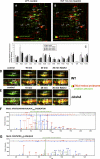S-bacillithiolation protects against hypochlorite stress in Bacillus subtilis as revealed by transcriptomics and redox proteomics
- PMID: 21749987
- PMCID: PMC3226405
- DOI: 10.1074/mcp.M111.009506
S-bacillithiolation protects against hypochlorite stress in Bacillus subtilis as revealed by transcriptomics and redox proteomics
Abstract
Protein S-thiolation is a post-translational thiol-modification that controls redox-sensing transcription factors and protects active site cysteine residues against irreversible oxidation. In Bacillus subtilis the MarR-type repressor OhrR was shown to sense organic hydroperoxides via formation of mixed disulfides with the redox buffer bacillithiol (Cys-GlcN-Malate, BSH), termed as S-bacillithiolation. Here we have studied changes in the transcriptome and redox proteome caused by the strong oxidant hypochloric acid in B. subtilis. The expression profile of NaOCl stress is indicative of disulfide stress as shown by the induction of the thiol- and oxidative stress-specific Spx, CtsR, and PerR regulons. Thiol redox proteomics identified only few cytoplasmic proteins with reversible thiol-oxidations in response to NaOCl stress that include GapA and MetE. Shotgun-liquid chromatography-tandem MS analyses revealed that GapA, Spx, and PerR are oxidized to intramolecular disulfides by NaOCl stress. Furthermore, we identified six S-bacillithiolated proteins in NaOCl-treated cells, including the OhrR repressor, two methionine synthases MetE and YxjG, the inorganic pyrophosphatase PpaC, the 3-D-phosphoglycerate dehydrogenase SerA, and the putative bacilliredoxin YphP. S-bacillithiolation of the OhrR repressor leads to up-regulation of the OhrA peroxiredoxin that confers together with BSH specific protection against NaOCl. S-bacillithiolation of MetE, YxjG, PpaC and SerA causes hypochlorite-induced methionine starvation as supported by the induction of the S-box regulon. The mechanism of S-glutathionylation of MetE has been described in Escherichia coli also leading to enzyme inactivation and methionine auxotrophy. In summary, our studies discover an important role of the bacillithiol redox buffer in protection against hypochloric acid by S-bacillithiolation of the redox-sensing regulator OhrR and of four enzymes of the methionine biosynthesis pathway.
Figures









Similar articles
-
S-bacillithiolation protects conserved and essential proteins against hypochlorite stress in firmicutes bacteria.Antioxid Redox Signal. 2013 Apr 10;18(11):1273-95. doi: 10.1089/ars.2012.4686. Epub 2012 Oct 18. Antioxid Redox Signal. 2013. PMID: 22938038 Free PMC article.
-
Redox regulation in Bacillus subtilis: The bacilliredoxins BrxA(YphP) and BrxB(YqiW) function in de-bacillithiolation of S-bacillithiolated OhrR and MetE.Antioxid Redox Signal. 2014 Jul 20;21(3):357-67. doi: 10.1089/ars.2013.5327. Epub 2014 Mar 13. Antioxid Redox Signal. 2014. PMID: 24313874 Free PMC article.
-
Protein S-Bacillithiolation Functions in Thiol Protection and Redox Regulation of the Glyceraldehyde-3-Phosphate Dehydrogenase Gap in Staphylococcus aureus Under Hypochlorite Stress.Antioxid Redox Signal. 2018 Feb 20;28(6):410-430. doi: 10.1089/ars.2016.6897. Epub 2017 Jan 18. Antioxid Redox Signal. 2018. PMID: 27967218 Free PMC article.
-
The Role of Bacillithiol in Gram-Positive Firmicutes.Antioxid Redox Signal. 2018 Feb 20;28(6):445-462. doi: 10.1089/ars.2017.7057. Epub 2017 Apr 24. Antioxid Redox Signal. 2018. PMID: 28301954 Free PMC article. Review.
-
Redox regulation by reversible protein S-thiolation in bacteria.Front Microbiol. 2015 Mar 16;6:187. doi: 10.3389/fmicb.2015.00187. eCollection 2015. Front Microbiol. 2015. PMID: 25852656 Free PMC article. Review.
Cited by
-
PRIDE: quality control in a proteomics data repository.Database (Oxford). 2012 Mar 20;2012:bas004. doi: 10.1093/database/bas004. Print 2012. Database (Oxford). 2012. PMID: 22434838 Free PMC article.
-
Protective role of bacillithiol in superoxide stress and Fe-S metabolism in Bacillus subtilis.Microbiologyopen. 2015 Aug;4(4):616-31. doi: 10.1002/mbo3.267. Epub 2015 May 18. Microbiologyopen. 2015. PMID: 25988368 Free PMC article.
-
S-bacillithiolation protects conserved and essential proteins against hypochlorite stress in firmicutes bacteria.Antioxid Redox Signal. 2013 Apr 10;18(11):1273-95. doi: 10.1089/ars.2012.4686. Epub 2012 Oct 18. Antioxid Redox Signal. 2013. PMID: 22938038 Free PMC article.
-
The Disulfide Stress Response and Protein S-thioallylation Caused by Allicin and Diallyl Polysulfanes in Bacillus subtilis as Revealed by Transcriptomics and Proteomics.Antioxidants (Basel). 2019 Nov 29;8(12):605. doi: 10.3390/antiox8120605. Antioxidants (Basel). 2019. PMID: 31795512 Free PMC article.
-
The human allicin-proteome: S-thioallylation of proteins by the garlic defence substance allicin and its biological effects.Free Radic Biol Med. 2019 Feb 1;131:144-153. doi: 10.1016/j.freeradbiomed.2018.11.022. Epub 2018 Nov 27. Free Radic Biol Med. 2019. PMID: 30500420 Free PMC article.
References
-
- Imlay J. A. (2003) Pathways of oxidative damage. Annu. Rev. Microbiol. 57, 395–418 - PubMed
-
- Hawkins C. L., Pattison D. I., Davies M. J. (2003) Hypochlorite-induced oxidation of amino acids, peptides and proteins. Amino Acids 25, 259–274 - PubMed
-
- Faulkner M. J., Helmann J. D. (2011) Peroxide stress elicits adaptive changes in bacterial metal ion homeostasis. Antioxid Redox Signal. doi 10.1089/ars.2010.3682 - DOI - PMC - PubMed
Publication types
MeSH terms
Substances
LinkOut - more resources
Full Text Sources
Medical
Molecular Biology Databases
Miscellaneous

